How to Use Baby Sign Language to Improve Mealtime Communication with @signngrow Mary Smith
- Signing does not delay speech; using sign language with hearing children will not cause them to delay speech and in fact, research suggests it may advance childhood speech
- Benefits of signing at mealtime and which words to use beyond “more” and “all done”
- The best time to start signing with your baby and when you should start expecting your baby to sign back
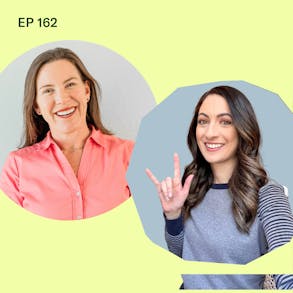
LISTEN TO THIS EPISODE
Episode Description
Curious about communicating with your baby… especially during meal time? Today’s guest Mary Smith shares how sign language can be a fun and educational learning experience for both parent and baby!
Mary Smith @signngrow is a Licensed Educational American Sign Language Interpreter in Colorado with a degree in Deaf Studies. She is the founder and instructor at Sign ‘n Grow where she teaches parents how to communicate with their babies early.
About the Guest
- Mary Smith received her degree in Deaf Studies in 2010 and has provided Sign Language services in the Deaf community for nearly 10 years in both California and Colorado
- Founder and instructor of Sign ‘n Grow Baby Sign Language
- Follow @signngrow on IG, Sign ‘n Grow on FB

Links from this Episode
- Baby Signs for Growing Minds: sing a long section, 65 signs
- Baby-Led Weaning with Katie Ferraro program with the 100 First Foods™ Daily Meal Plan, join here: https://babyledweaning.co/program
- Baby-Led Weaning for Beginners free online workshop with 100 First Foods™ list to all attendees, register here: https://babyledweaning.co/baby-led-weaning-for-beginners

Latest Episodes
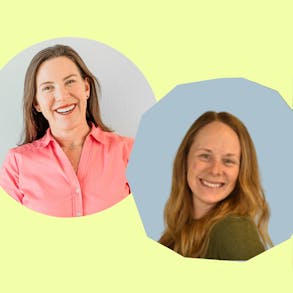
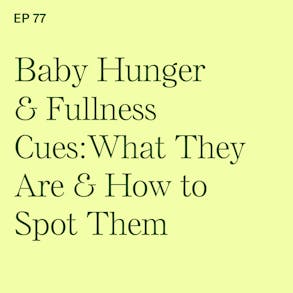
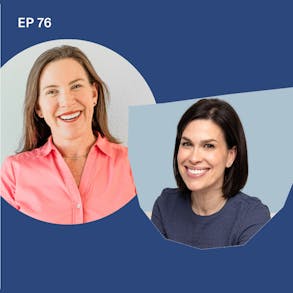
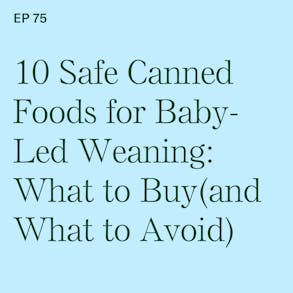
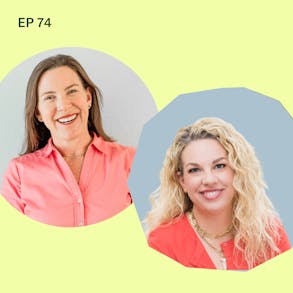
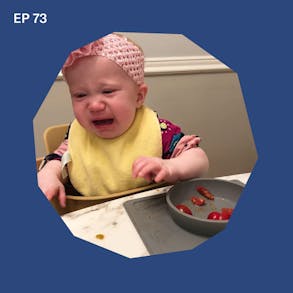
Mary Smith (0s):
But benefit for using signs at mealtime is that you can actually know if your baby is still hungry or if they are full, which as parents we know with babies, it's always a guessing game. Do they want more or not?
Katie Ferraro (15s):
Hey, there I'm Katie Ferraro, registered dietitian college nutrition professor, and mama of seven specializing in baby led weaning here on the baby led weaning made easy podcast. I help you strip out all of the noise and nonsense about feeding, feeding me with the competence and knowledge. You need to give your baby a safe start to solid foods using baby led weaning. Hey guys, welcome back today. We're talking about sign language and how to use baby sign language to improve mealtime communication. My guest today is Mary Smith. If you guys are on Instagram, she's @signngrow the letter N she's a licensed educational American sign language interpreter in Colorado.
Katie Ferraro (60s):
She has a degree in deaf studies and she's the founder and instructor at sign and grow where she teaches parents, how to communicate with their babies early full disclosure. I never did sign language with any of my seven babies. I've no idea what I'm doing. I learned a few signs today on the podcast with Mary. She's going to tell us some of the ones that she thinks are best for starting out at mealtime with she's got some other options for those of you that want to do like more than the basics, but also she helps to debunk some myths. Cause I had heard that like, if you do sign language at mealtime or you do sign language with your babies in general, it actually could delay their speech. And she's telling me why that's totally not true. And she's going to sell you on sign language for your baby if you're not already sold.
Katie Ferraro (1m 40s):
So with no further ado, let's dive in. This is all about how to use baby sign language, to improve mealtime communication with sign and grow Mary Smith. Well, hi Mary and welcome to the podcast. I'm so excited to me when chat with you today.
Mary Smith (1m 54s):
Hey, thank you so much for having me.
Katie Ferraro (1m 55s):
All right. So tell Us a little bit about your background. How did you get into this line of work? What is it that you do? Why do you do it? Tell us all the things
Mary Smith (2m 4s):
All right. So I'm an American sign language interpreter. I actually learned sign language in college in Southern California. I just really loved learning sign language. And I decided to become an interpreter because I love all things that have to do with language. And I have a degree in deaf studies. So the deaf community is very near and dear to my heart. And I work with the deaf community on an ongoing basis. And I knew that I wanted to use sign language with my daughter whenever she was born. And she's now three years old when she was born, I was using some sign language with her to help her communicate freely. And I know that there are so many parents out there who do the same thing and who feel kind of lost because they don't have a background in sign language.
Mary Smith (2m 52s):
So I decided from seeing the success of being able to communicate with her, that I should teach other parents. And that's what I started to do. And I started my company sign and grow.
Katie Ferraro (3m 4s):
Awesome. So tell me a little bit about sign and grow I know you from Instagram. I am like, I feel like every time I watch your page, I learn so much. Is that where you do most of your promotion? Do you have courses, like what is it that you are doing to help parents learn about sign language? Cause I feel like it's really intimidating if you don't know anything about it,
Mary Smith (3m 21s):
Absolutely. On the site and grow Instagram page, I kind of keep it as an introduction so that parents can learn just how to introduce sign language, to their babies for early communication. And we call it baby sign language. That's this concept of teaching, hearing babies to sign up for early communication until they start to talk and then parents phase out the signs. So I'm kind of helping parents pick and choose which signs are the most important ones for them to use. And then also strategies for teaching them to babies because babies learn in such a different way than we teach older children and also adults. So babies need just a whole set of their own strategies.
Mary Smith (4m 2s):
And then also all of the things that have to do with language development for babies,
Katie Ferraro (4m 6s):
And I am going to get to like, what are the most important ones to start with in a second? But I want to just back up real quick because are there benefits to teaching a baby sign language? And I want to tell you like my real life story is that I always felt inadequate because my friends would like show up with babies that were like doing signs. And I was like, dude, my babies don't know any signs, but then I was like, someone told me and I'm sure this is untrue, but it made me feel better. Oh, if babies use sign language, then they get reliant on the signs and they won't use real words. So I used to be like, oh, it's okay. They don't do sign language because I want them to use real words because they could hear, is that true? False? Do you hear that? Like myths a lot? What's the deal with that stuff?
Mary Smith (4m 41s):
Well, a few things to unpack there, but first things, first signs you not delayed speech. So the research has shown time and time again that using sign language with hearing children will not delay their ability to speak. I'll pull out. Some research has actually found that using sign language can help to accelerate speech. I think that it really depends on what type of strategies that you're using, which is why I focus so much more on strategies in what I teach rather than just learning the signs because let's be honest, you can Google whatever sign you want to know, but the strategies are really where it's at. We still do need more research to know to what extent sign language can advance speech.
Mary Smith (5m 26s):
Some research is showing that it doesn't offend speech. Some research is showing that it does, but the research has definitively proven that it does not delay speech. So this whole idea that babies will become lazy and they'll rely on the signs. It's actually not true. What I see time and time again. And what the research has also proven is that babies do really want to speak to us. But the thing is that more than that, they want to communicate with us. So when we give them the opportunity to communicate with us before they can speak, they take that opportunity and they use those sides. But once they're able to say those words, they are all about saying those words because their parents are saying the words and they really know that the entire world around them is using spoken language.
Mary Smith (6m 15s):
So they want to do it to.
Katie Ferraro (6m 16s):
So I was going to ask you, what are some of the benefits of baby sign language, but as I understand it, it's basically to help improve communication at an earlier age than when a hearing child might be able to communicate verbally. Is that correct?
Mary Smith (6m 30s):
Absolutely. There are several benefits to using baby sign, language, sign language with hearing children. So the biggest thing is being able to communicate early. So babies from around six to eight months old are already able to know what they need from us, but they're not able to vocalize that until past 12 months old. So for a big chunk of time there, especially when they're still infants, it's very frustrating for both of them and us that we can't give them what they know that they need. So the signs gives them a way to communicate what they need in the meantime. And by doing that, several things happen.
Mary Smith (7m 11s):
First things first, our babies are less frustrated because we're able to meet their needs. We're less stressed because we know what they need from us. And then also we're able to bond more because we're spending less time being frustrated and having that lack of communication. We're spending more time actually working together as a team with our baby to get their needs met and doing all of that. Just leads to a whole bunch of bonding, keeping in mind, also that using science with your baby in language development sign language is a real language. So again, what that person said to you about, oh, then they will use real words. Find the are actually real words.
Mary Smith (7m 52s):
They're words in a different language. So by language in English are separate sign. Language is not English on the hand, it's a completely separate language. So when we're teaching our baby a few words in sign language, a few signs, they're actually able to use this new language to communicate with us, which is really, really cool. And that also draws our attention to communicating more with our babies. They're looking at us for the signs. We're looking at them to see their signs were making more eye contact for paying attention to each other. We're less frustrated the benefits go on and on.
Katie Ferraro (8m 28s):
This is amazing, I have learned so much already and I feel bad. I hope it was not insulting to your tire professional because I was like, I just always felt so like intimidated by sign language. I guess. Like I am older than most moms. I feel like in my community at this point, for sure. And I was like, I don't have the capacity to learn a new language. Like, can you teach an old dog new tricks? Like I feel like parents have to learn at first. And then babies. It seems like a lot. Like how do you help parents start sign language?
Mary Smith (8m 54s):
So the thing is that it does seem like a really big hill to climb, but the fact is that you don't have to learn the whole language. So you can just learn this a couple of words. So the same way that in any other language, if you wanted to learn just a couple of words, you definitely could. Same thing with sign language, you can learn just a handful of science, whatever that you find useful, and then just use those signs in your daily routines that you already have with your baby. So whenever you're speaking that word out loud, you use the as well. So what we're doing is we're just adding in the science to our everyday interactions with our babies. So you don't have to do something completely separate.
Mary Smith (9m 35s):
ASL does have a different grammar than English does, but you don't have to learn ASL grammar. If you're using just one sign at a time, you can just use it while you are speaking, whatever language that you're speaking to your baby. And it just becomes part of your daily infractions.
Katie Ferraro (9m 52s):
So Mary, mealtimes can be really stressful for parents, especially when they're just starting out with starting solids and baby led weaning convinced us, I guess, how can sign language be beneficial for these parents when they're going to feeding their baby? Like, what's the benefit of doing this at mealtime?
Mary Smith (10m 6s):
The benefit for using signs at mealtime is that you can actually know if your baby is still hungry or if they are full, which as parents we know with babies, it's always a guessing game. Do they want more or not? Why are they fussing? Is it because they don't like the food or is it because they're done and I keep on feeding them or is it because they want more and instead it's really confusing. So you think some simple signs and mealtimes can actually help you take out the guesswork from wondering if your baby is still hungry or done.
Katie Ferraro (10m 38s):
Yeah. All right. So can you give me some ideas? I know we're on a podcast and we're not showing the signs, but like what are some give a list of words to start with at mealtime? What are good ones to learn? Are there words we should not be using in sign language at meal time? Can you kind of talk us around some of the mealtimes specific sign language,
Mary Smith (10m 55s):
The mealtime science, the two main ones are going to be more and all done.
Katie Ferraro (10m 60s):
Those are the only two I know. So I'm glad you started with those
Mary Smith (11m 5s):
And you can start small. You don't have to learn like dozens of signs. If you just use more and all of that with your baby, then you're at least getting a little bit of that communication and easing a little bit of that frustration. So just using the sign more, every time that you're giving your baby more food. And if you do that, there's a hot tip. If you do smaller bites or smaller chunks of food, then you're able to use the sign every single time that you are giving them that small bite. So you're able to use a sign more and more, and then use the sign for all done at the very end of the meal. That way your baby knows the sign.
Mary Smith (11m 46s):
More means that the meal is still going. The sign all done means. If the meal is over,
Katie Ferraro (11m 51s):
Explain for those of us listening, what do the signs look like for more and all done? I love watching you describe how to do a sign. It's like so fascinating to me, but we're listening to it. So how can we do this over? Like, are your buds here?
Mary Smith (12m 5s):
So the science for more is made with two letter "o's". So if you take both hands and you make the letter O with both hands, and then you're going to tap the tips of your fingers together twice one, two,
Katie Ferraro (12m 18s):
That's more, all right, what's all done, Mary.
Mary Smith (12m 20s):
Oh, then you're going to hold up both hands and spread out your fingers. Like you're making, like, you're holding up the number 10 and you're going to turn them back. So you're going to turn them back. So they're going to be up kind of by your ears almost so above your shoulders. And they're going to be facing behind you. This is where the sign starts. Then you are going to bring them forward. So you're going to flip them forward so that now your hands are facing forward. And that is the sign for all done. You can make some movement once or you can make it both ways are correct.
Katie Ferraro (12m 53s):
I feel like an expert now. Okay. Let's round two. What are some other good signs for parents to know at mealtime beyond more in all done? If they're like advanced level.
Mary Smith (13m 3s):
So you can also use a sign for food that can help your baby request whenever they are hungry and it's not mealtime yet the best time it keeps the sign for food though, is to teach it during mealtimes. At first, that way your baby starts to associate the sign with mealtimes. So that then whenever you're using it outside of mealtimes, they know what it means.
Katie Ferraro (13m 25s):
And am I using the language incorrectly? Is it called us sign or is it a word
Mary Smith (13m 31s):
That's fine? That's fine. Tie-ins forwards, but you can call it a fine, just for clarity space.
Katie Ferraro (13m 37s):
Mary, I know your daughter is three years old and most of the people listening have at least a baby who is somewhere younger than six to 12 months of age. Could you take us back in time to when you were doing sign language with your daughter, any tips for parents who want to start doing this and what worked for you or any stories you can share about your own experience?
Mary Smith (13m 58s):
Yes, absolutely. So a couple of things kind of embarrassing to admit, but I actually got a little bit of a later start with finding to my daughter because part of Ms card, and it just took me a while to bounce back. And then by the time that I actually really got down to consistently assigning with her, she was around 10 months old. But I do recommend that if parents are ready to start earlier than that, and we can talk about that in a minute, but I started with her more consistently around 10 months old. And then she started signing back a couple of months later. So it does take a little bit of time for babies to use any language, the same way with spoken language, that it takes them a while to talk.
Mary Smith (14m 41s):
It takes them a while to find two. It just happens earlier than the spoken language does. So it took her a couple of months, but I just remember by the time that she was 12 months old, she was signing more babies. When they sign their signs, don't look correctly. So the same way that your baby might say Wawa for water and their signs still look exactly. Right? So sometimes when babies are trying to sign more, it might look like almost like they're clapping, or it might look like they're tapping their Palm with their finger. So that was her go-to. And that's a really common one for tapping the Palm with a finger for their sign more. And I have her on video. She's just tapping and saying ma at the same time.
Mary Smith (15m 23s):
So she's signing and she's saying ma and she keeps on coming back to me for blueberries. She was walking around the room and just kept on coming back. And I was just kept on giving her blueberries. And it's just so nice to know that they're able to actually ask for what they want. So they're not just getting what they want from whining or fussing, but they're actually able to use language to ask for it. And it's just so fun.
Katie Ferraro (15m 49s):
It's when you're like, oh my gosh, they're a real person. Like, you know, the first six weeks I think are so brutal. I didn't feel like my babies always smiled at six weeks. And I was like, oh, that's why I'm doing this. Like, you are reacting. You are a human being. Like, it's so fun to communicate with them with, I mean, smiling is one way to communicate speaking. His sign language is another way. What is the best time to start signing? You mentioned you thought 10 months was late, but what do you recommend for parents who want to try this approach?
Mary Smith (16m 14s):
So late for me, because I wanted to start at birth. And, but it's actually not late for parents in general. So if parents want to start and their baby is a little bit older, that is totally, totally fine. What I tell parents is start whenever you feel ready. So like I said, my postpartum journey was a bit tough, so I just wasn't really ready to take it on consistently yet. But a lot of parents do choose to start at six months old because I kind of lend themselves to mealtimes, to starting solids. So it kind of just naturally lends itself to incorporating signs during meal times around six months old or whenever your baby is starting solids, if you're ready to start earlier than that, who definitely can, you can start while you're giving your baby milk or formula, however you're feeding your baby.
Mary Smith (17m 8s):
If your baby is older and they've already been doing fellows for awhile, even if they're past a year old, if the baby is not speaking freely with you yet, if you don't have that free communication yet I did some signs and see what happens.
Katie Ferraro (17m 23s):
Maybe I also know you have a brand new course that get expanded version of that. That just came out. Could you tell us a little bit about that new offering?
Mary Smith (17m 31s):
I now have a full length online course called baby signs for growing minds. And my full length course includes over 65 signs for your babies. Everyday life, mealtimes feelings, family time, play time, everything. And it also has a sing along section where we sing songs and learn signs and gestures, Lao. We're singing songs with our baby. So you can use it as an interactive course, plus as a parent to learn a whole bunch of strategies for teaching your baby, how to sign,
Katie Ferraro (18m 6s):
So, Mary, Where can we go to learn more about sign and grow and about your programs about your courses? Like this is so fascinating. I know people are going to want to snatch it up right now.
Mary Smith (18m 16s):
Absolutely. You can go to my Instagram page. I have so much free information on there. It's @signngrow. So it's not sign and grow. It's sign, a letter n grow. I do have so much information on there. And my highlights in my reels feel free to take a poke around if you do want to get started right now, I do have a mini course that you can watch on your own time in the mini course, I share with you the top 10 everyday signs to use with your baby. So I have a mealtimes lesson and by having a daytime sign lesson, and you also get a whole bunch of strategies in that mini course that you can apply to any signs that you want to teach your little one.
Katie Ferraro (19m 1s):
Thank you so much for sharing with us. This has been very eye opening to me, and I know a lot of parents are so grateful for you. You're such a wonderful resource. You have such a fabulous way of communicating things, which I think is very important in your field. And I just want to say thank you so much for sharing your time with us today.
Mary Smith (19m 16s):
Thank you for having me.
Katie Ferraro (19m 18s):
Well, I hope you guys enjoyed that interview with Mary Smith. She's on Instagram @signngrow the letter, and I'm going to link to all of her resources, including her mini course, her more expanded course, her Instagram. If you guys are interested in sign language for your babies, you've got to check out Mary don't forget she's a licensed educational American sign language interpreter. So that's in the state of Colorado, but she has a degree in deaf studies and we had kind of a side conversation talking about, you know, who should be and who should not be teaching sign language. I always try to bring on credentialed experts in their respective fields to the podcast because it's so important that we're getting our information from the people who specialize in this. So she was such a wealth of knowledge.
Katie Ferraro (19m 58s):
I hope you guys enjoyed this interview and I'll link everything from Mary's interview up in the show notes for this episode, which you can find at blwpodcasts.com/162

The Program Baby-Led Weaning with Katie Ferraro
A step-by-step digital program for starting solid foods safely and navigating the original 100 FIRST FOODS™ meal plan with baby-led weaning.
 EXPERT-LED, PROVEN APPROACH TO EATING REAL FOOD
EXPERT-LED, PROVEN APPROACH TO EATING REAL FOOD CONCISE VIDEO TRAININGS TO MASTER BABY-LED WEANING
CONCISE VIDEO TRAININGS TO MASTER BABY-LED WEANING 100 FIRST FOODS DAILY MEAL PLAN WITH FOOD PREP VIDEOS
100 FIRST FOODS DAILY MEAL PLAN WITH FOOD PREP VIDEOS
Baby-Led Weaning for Beginners Free Workshop
Is your baby ready to start solid foods, but you’re not sure where to start? Get ready to give your baby a solid foundation to a lifetime of loving real food…even if you’re feeling overwhelmed or confused about this next stage of infant feeding.
Get baby-led weaning recipes and tips delivered to your email inbox.

